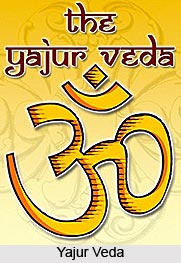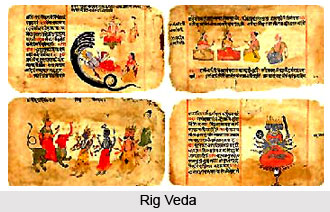 Adhyayas of Yajur Veda consist of a number of prayers and sacrificial formulae which form the principal contents of the Yajur Veda. The chapters contain partly of verses and partly of prose sentences. It is the latter which are called "Yajus," and from which the Yajur Veda takes its name. The prose of these prayers is occasionally rhythmical and here and there even rises to poetical flight. The verses which occur are mostly found also in the Rig Veda Samhita. The various readings, however, which the Yajur Veda often presents, are mostly intentional alterations which were made in the verses, in order to bring them more into line with the sacrificial acts. Only rarely were whole hymns of the Rig Veda included in the Yajur Veda Samhitas. Mostly they are only single verses, torn from their context, which just appeared suitable to some sacrificial ceremony or other, and were therefore included in the Veda of prayers.
Adhyayas of Yajur Veda consist of a number of prayers and sacrificial formulae which form the principal contents of the Yajur Veda. The chapters contain partly of verses and partly of prose sentences. It is the latter which are called "Yajus," and from which the Yajur Veda takes its name. The prose of these prayers is occasionally rhythmical and here and there even rises to poetical flight. The verses which occur are mostly found also in the Rig Veda Samhita. The various readings, however, which the Yajur Veda often presents, are mostly intentional alterations which were made in the verses, in order to bring them more into line with the sacrificial acts. Only rarely were whole hymns of the Rig Veda included in the Yajur Veda Samhitas. Mostly they are only single verses, torn from their context, which just appeared suitable to some sacrificial ceremony or other, and were therefore included in the Veda of prayers.
The simplest prayer found is the dedication of a sacrificial gift with the mere utterance of the name of the deity to which it is offered. Formulae of this kind are numerous in the Yajur Veda. "Thee for Agni, "thee for Indra," or "this for Agni," or also "for Agni Hail" "for Indra Hail!" etc- with such words the gift is laid down or thrown into the sacred fire. A shorter and simpler song of praise to a god can hardly be imagined than the words with which every morning and every evening the fire-sacrifice consisting of milk (Agnihotra) is offered: "Agni is Light, Light is Agni, Hail!" (in the evening), and "Surya is Light, Light is Surya, Hail!" (in the morning). In equally brief words the purpose of a sacred act is often indicated when, for instance, the sacrificial priest cuts off the branch with which the calves are driven from the cows, and says at the same time: "Thee for juice, thee for strength!" The deities are not always invoked or praised in these sacrifice-formulae, but in the most diverse ways sacrificial utensils and sacrificial acts are brought into relation with the deities. Thus, for example, the priest binds with a rope the sacrificer`s wife who takes part in the sacrifice, saying: "A girdle thou art for Aditi" and so on.
There are a number of formula like turns in the Yajur Veda which convey little or no meaning. Comparatively, however, rarely does one come across long prose prayers in which the sacrificer expresses his desires to the deity in simple words. Some prayer-formulae of the Yajur Veda are indeed nothing but magic spells in prose. Even exorcisms and curses, quite similar to those found in the Atharva Veda, can be seen among the prayers of the Yajur Veda. For there exist also sacrificial acts by which one can injure an enemy. Thus the priest says to the yoke of the car on which the sacrificial utensils are kept: "A yoke thou art, injure the injurer, injure him who injures us, injure him whom we injure."
Just as these exorcism-formulae have a primitive and popular air, even the riddles can be found possessing similar qualities. The genuinely theological riddles deserve the technical name of Brahmodya as they presuppose an acquaintance with Brahman or sacred knowledge. In the Yajur Veda one can also learn of the occasions at which the riddle-games were customary, indeed, even formed a part of the cult. Thus, in the Vajasaneyi Samhita in section XXIII, 2, a number of riddles with which the priests amused themselves at the renowned ancient horse sacrifice. These riddle games form an equally important part of the worship of the gods as the prayers and sacrificial formulae. However, the term "worship" of the gods expresses inadequately the purpose of the prayers and formulae, indeed, of the sacrifices themselves. The majority of the sacrificial ceremonies, as also the Yajus formulae do not aim at "worshipping" the gods, but at influencing them, at compelling them to fulfil the wishes of the sacrifice. The gods wish to be not only fed, but entertained as well.
 In the Yajur Veda can be found besides, already a mode of influencing the gods which prevailed very largely at later periods, and which consists of enumerating as many names and epithets as possible pertaining to a certain god and of worshipping him under all these names, in order to obtain something from him. Thus in the later literature there can be found texts which enumerate a thousand names of Lord Vishnu or a thousand names of Lord Shiva, the recital of which is regarded as a particularly effective and meritorious work of devotion. The first beginnings of this kind of prayers are found in the Satarudriya, the enumeration of the hundred names of the god Rudra, in Section XVI of the Vajasaneyi Samhita and in the Taittiriya Samhita.
In the Yajur Veda can be found besides, already a mode of influencing the gods which prevailed very largely at later periods, and which consists of enumerating as many names and epithets as possible pertaining to a certain god and of worshipping him under all these names, in order to obtain something from him. Thus in the later literature there can be found texts which enumerate a thousand names of Lord Vishnu or a thousand names of Lord Shiva, the recital of which is regarded as a particularly effective and meritorious work of devotion. The first beginnings of this kind of prayers are found in the Satarudriya, the enumeration of the hundred names of the god Rudra, in Section XVI of the Vajasaneyi Samhita and in the Taittiriya Samhita.
Finally, there is yet another kind of "prayers," which are found in the Yajur Veda. They are single syllables or words, which convey no meaning at all, or whose meaning has been lost. They are pronounced in the most solemn manner at certain places in the act of sacrifice, and are regarded as immensely sacred. There is, first of all, the sacrificial cry Svaha, which can be translated as "Hail", with which every gift for the gods is thrown into the fire, while the cry Svadha is employed in the case of sacrificial gifts to the fathers. Other such cries of sacrificial worship include Vasat, Vet, Vat, but above all the most sacred syllable Om. This syllable has been regarded in India for thousands of years, and still to the present day is regarded, as inordinately sacred and full of mystical significance. In the Upanishads it is identified with Brahman, the world-soul, and recommended to the wise man as the highest subject of meditation. Centuries later, in the Tantras, the religious books of more recent Indian sects, the use of such mystical syllables and words has become prevalent to such an extent that one can frequently find nothing for pages, but inarticulate sounds such as Um, Am, Hrim, Um, Em, Krom, Phat, Ah, and so on. It is significant too, that the word mantra, which originally designated the verses and prayers of the Vedic Samhitas, later on had only the meaning of "magic formula." Already in the Yajur Veda we can trace quite clearly the transition from prayer to magic formula-the two had, in fact, never been very strictly separated.
The Yajur Veda Samhitas are supremely important, indeed, interesting literary works for the student of religion, who studies them as sources not only for the Indian, but also for the general science of religion. It delves rather deeply into and provides a profound insight into the origin, the development, and the significance of prayer in the history of religion. For the understanding of the whole of the later religious and philosophical literature of the Indians, too, these Samhitas are indispensable. Without the Yajur Veda one cannot understand the Brahmanas, and without these one cannot understand the Upanishads.



















